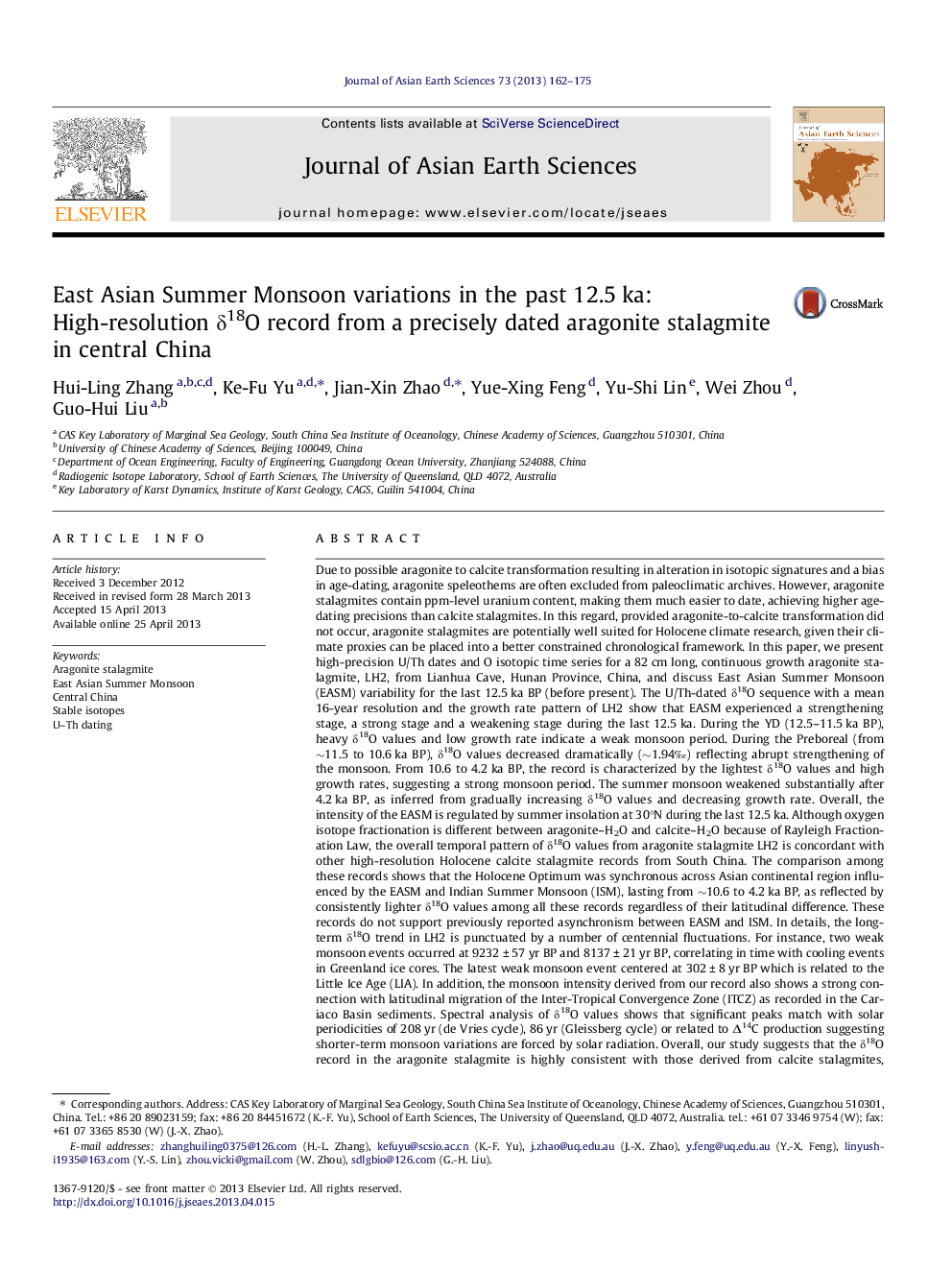| کد مقاله | کد نشریه | سال انتشار | مقاله انگلیسی | نسخه تمام متن |
|---|---|---|---|---|
| 6444484 | 1640394 | 2013 | 14 صفحه PDF | دانلود رایگان |
عنوان انگلیسی مقاله ISI
East Asian Summer Monsoon variations in the past 12.5 ka: High-resolution δ18O record from a precisely dated aragonite stalagmite in central China
دانلود مقاله + سفارش ترجمه
دانلود مقاله ISI انگلیسی
رایگان برای ایرانیان
کلمات کلیدی
موضوعات مرتبط
مهندسی و علوم پایه
علوم زمین و سیارات
زمین شناسی
پیش نمایش صفحه اول مقاله

چکیده انگلیسی
Due to possible aragonite to calcite transformation resulting in alteration in isotopic signatures and a bias in age-dating, aragonite speleothems are often excluded from paleoclimatic archives. However, aragonite stalagmites contain ppm-level uranium content, making them much easier to date, achieving higher age-dating precisions than calcite stalagmites. In this regard, provided aragonite-to-calcite transformation did not occur, aragonite stalagmites are potentially well suited for Holocene climate research, given their climate proxies can be placed into a better constrained chronological framework. In this paper, we present high-precision U/Th dates and O isotopic time series for a 82 cm long, continuous growth aragonite stalagmite, LH2, from Lianhua Cave, Hunan Province, China, and discuss East Asian Summer Monsoon (EASM) variability for the last 12.5 ka BP (before present). The U/Th-dated δ18O sequence with a mean 16-year resolution and the growth rate pattern of LH2 show that EASM experienced a strengthening stage, a strong stage and a weakening stage during the last 12.5 ka. During the YD (12.5-11.5 ka BP), heavy δ18O values and low growth rate indicate a weak monsoon period. During the Preboreal (from â¼11.5 to 10.6 ka BP), δ18O values decreased dramatically (â¼1.94â°) reflecting abrupt strengthening of the monsoon. From 10.6 to 4.2 ka BP, the record is characterized by the lightest δ18O values and high growth rates, suggesting a strong monsoon period. The summer monsoon weakened substantially after 4.2 ka BP, as inferred from gradually increasing δ18O values and decreasing growth rate. Overall, the intensity of the EASM is regulated by summer insolation at 30°N during the last 12.5 ka. Although oxygen isotope fractionation is different between aragonite-H2O and calcite-H2O because of Rayleigh Fractionation Law, the overall temporal pattern of δ18O values from aragonite stalagmite LH2 is concordant with other high-resolution Holocene calcite stalagmite records from South China. The comparison among these records shows that the Holocene Optimum was synchronous across Asian continental region influenced by the EASM and Indian Summer Monsoon (ISM), lasting from â¼10.6 to 4.2 ka BP, as reflected by consistently lighter δ18O values among all these records regardless of their latitudinal difference. These records do not support previously reported asynchronism between EASM and ISM. In details, the long-term δ18O trend in LH2 is punctuated by a number of centennial fluctuations. For instance, two weak monsoon events occurred at 9232 ± 57 yr BP and 8137 ± 21 yr BP, correlating in time with cooling events in Greenland ice cores. The latest weak monsoon event centered at 302 ± 8 yr BP which is related to the Little Ice Age (LIA). In addition, the monsoon intensity derived from our record also shows a strong connection with latitudinal migration of the Inter-Tropical Convergence Zone (ITCZ) as recorded in the Cariaco Basin sediments. Spectral analysis of δ18O values shows that significant peaks match with solar periodicities of 208 yr (de Vries cycle), 86 yr (Gleissberg cycle) or related to Î14C production suggesting shorter-term monsoon variations are forced by solar radiation. Overall, our study suggests that the δ18O record in the aragonite stalagmite is highly consistent with those derived from calcite stalagmites, suggesting that aragonite stalagmites are suitable for palaeoclimate reconstruction, especially for the Holocene period, as aragonite-calcite transformation has not occurred.
ناشر
Database: Elsevier - ScienceDirect (ساینس دایرکت)
Journal: Journal of Asian Earth Sciences - Volume 73, 5 September 2013, Pages 162-175
Journal: Journal of Asian Earth Sciences - Volume 73, 5 September 2013, Pages 162-175
نویسندگان
Hui-Ling Zhang, Ke-Fu Yu, Jian-Xin Zhao, Yue-Xing Feng, Yu-Shi Lin, Wei Zhou, Guo-Hui Liu,